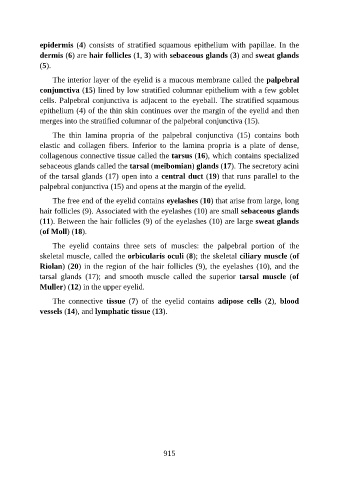Page 916 - Atlas of Histology with Functional Correlations
P. 916
epidermis (4) consists of stratified squamous epithelium with papillae. In the
dermis (6) are hair follicles (1, 3) with sebaceous glands (3) and sweat glands
(5).
The interior layer of the eyelid is a mucous membrane called the palpebral
conjunctiva (15) lined by low stratified columnar epithelium with a few goblet
cells. Palpebral conjunctiva is adjacent to the eyeball. The stratified squamous
epithelium (4) of the thin skin continues over the margin of the eyelid and then
merges into the stratified columnar of the palpebral conjunctiva (15).
The thin lamina propria of the palpebral conjunctiva (15) contains both
elastic and collagen fibers. Inferior to the lamina propria is a plate of dense,
collagenous connective tissue called the tarsus (16), which contains specialized
sebaceous glands called the tarsal (meibomian) glands (17). The secretory acini
of the tarsal glands (17) open into a central duct (19) that runs parallel to the
palpebral conjunctiva (15) and opens at the margin of the eyelid.
The free end of the eyelid contains eyelashes (10) that arise from large, long
hair follicles (9). Associated with the eyelashes (10) are small sebaceous glands
(11). Between the hair follicles (9) of the eyelashes (10) are large sweat glands
(of Moll) (18).
The eyelid contains three sets of muscles: the palpebral portion of the
skeletal muscle, called the orbicularis oculi (8); the skeletal ciliary muscle (of
Riolan) (20) in the region of the hair follicles (9), the eyelashes (10), and the
tarsal glands (17); and smooth muscle called the superior tarsal muscle (of
Muller) (12) in the upper eyelid.
The connective tissue (7) of the eyelid contains adipose cells (2), blood
vessels (14), and lymphatic tissue (13).
915

